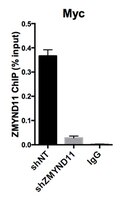ABE1889 Sigma-AldrichAnti-ZMYND11 Antibody
Detect ZMYND11 using this Anti-ZMYND11 Antibody validated for use in Western Blotting, Chromatin Immunoprecipitation (ChIP), ChIP-seq.
More>> Detect ZMYND11 using this Anti-ZMYND11 Antibody validated for use in Western Blotting, Chromatin Immunoprecipitation (ChIP), ChIP-seq. Less<<Prodotti consigliati
Panoramica
| Replacement Information |
|---|
Tabella delle specifiche principali
| Species Reactivity | Key Applications | Host | Format | Antibody Type |
|---|---|---|---|---|
| H | WB, ChIP, ChIP-seq | Rb | Serum | Polyclonal Antibody |
| References |
|---|
| Product Information | |
|---|---|
| Format | Serum |
| Presentation | Rabbit polyclonal serum with 0.05% sodium azide. |
| Quality Level | MQ100 |
| Physicochemical Information |
|---|
| Dimensions |
|---|
| Materials Information |
|---|
| Toxicological Information |
|---|
| Safety Information according to GHS |
|---|
| Safety Information |
|---|
| Packaging Information | |
|---|---|
| Material Size | 100 µL |
| Transport Information |
|---|
| Supplemental Information |
|---|
| Specifications |
|---|
| Global Trade Item Number | |
|---|---|
| Numero di catalogo | GTIN |
| ABE1889 | 04055977315721 |
Documentation
Anti-ZMYND11 Antibody MSDS
| Titolo |
|---|
Anti-ZMYND11 Antibody Certificati d'Analisi
| Titolo | Numero di lotto |
|---|---|
| Anti-ZMYND11 - 3200642 | 3200642 |
| Anti-ZMYND11 - 3732981 | 3732981 |
| Anti-ZMYND11 - 4046599 | 4046599 |
| Anti-ZMYND11 -Q2648345 | Q2648345 |
| Anti-ZMYND11 Polyclonal Antibody | 3057042 |












